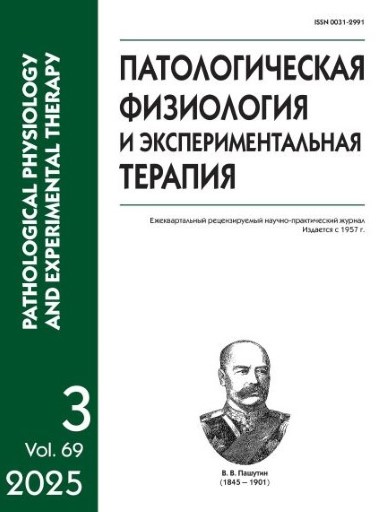Re The effect of photodynamic therapy and surgical treatment of experimental breast cancer on the relationship of microRNAs (-21, -27a, -221, -429) of thymic mRNA with the thymus structure
Abstract
Aim. To identify the effect of photodynamic therapy (PDT) and its combination with surgical treatment of breast cancer on the relationship of thymic microRNA (‑21, ‑27a, ‑221, ‑429) with the thymus structure in female Wistar rats.
Methods. The study was conducted on 80 anesthetized mature female Wistar rats. The relationship between the thymus structure and the amount of microRNA in the thymus was assessed after PDT for breast cancer (intramammary administration of N-methyl-N-nitrosourea) and after PDT and surgical treatment for breast cancer.
Results. After PDT, relationships were found only between pro-oncogenic microRNAs (‑21, ‑27a, ‑221) and cells in the corticomedullary zone and the central part of the medulla compared with the intact group and with breast cancer without treatment. Morphological changes in the thymus indicated the effect of PDT on the processes of both positive and negative selection. The relationships between thymic microRNAs and morphological changes in the thymus may indicate the effect of PDT on the attenuation of proliferative activity, differentiation and migration of T lymphocytes from the thymus compared to untreated breast cancer. PDT and subsequent surgical treatment of breast tumor, as compared to the PTD therapy, induced a significant increase in thymic microRNAs (‑21, ‑27a, ‑429). The following relationships were found: in the subcapsular zone, immunoblasts with microRNA‑21 and small lymphocytes with microRNA‑429; in the corticomedullary zone, small lymphocytes with microRNA‑27a; in the central part of the medulla, immunoblasts with microRNA‑21. Compared with PDT, the number of immunoblasts and medium lymphocytes decreased in the subcapsular zone and the central part of the cortical substance. The number of small lymphocytes increased in the central part of the cortical substance, and the number of small lymphocytes decreased in the central medulla and the corticomedullary zone. The number of epithelial reticular cells in the central part of the cortical substance and medullary substance was reduced.
Conclusion. This study revealed relationships of cells in thymus structural components with quantitative changes in thymic microRNA after PDT and surgical removal of the tumor, in comparison with PDT alone and along with morphological data. These relationships may be due to a decrease in the thymus proliferative activity, the activity of the processes of both positive and negative selection of T cells, as well as decreased activity of the processes of differentiation and migration of T lymphocytes from the thymus.
Downloads
References
2. Wang W., Thomas R., Sizova O., Su D-M. Thymic function associated with cancer development, relapse, and antitumor immunity - a mini-review. Front. Immunol: Sec. T cell biology. 2020; 11:773. doi: 10.3389/fimmu.2020.00773
3. Michael R.H., Heidi A. Factors Affecting Photodynamic Therapy and Anti-Tumor Immune Response. Anti-Cancer Agents in Medicinal Chemistry. 2021; 21(2): 123-36. doi: 10.2174/1871520620666200318101037
4. Aniogo E.C., Plackal Adimuriyil George B., Abrahamse H. The role of photodynamic therapy on multidrug resistant breast cancer. Cancer Cell Int. 2019; 19: ID 91. doi: 10.1186/s12935-019-0815-0
5. Kazakov O.V., Kabakov A.V., Poveshchenko A.F., Kononchuk V.V., Strunkin D.N., Gulyaeva L.F., Konenkov V.I. Effect of photodynamic therapy on the level of microRNA in breast cancer tissues of female Wistar rats. Bjulleten' jeksperimental'noj biologii i mediciny. 2022; 173(4): 452-5. doi: 10.47056/0365-9615-2022-173-4-452-455 (In Russian).
6. Anzengruber F., Avci P., de Freitas L.F., Hamblin M.R. T-cell mediated anti-tumor immunity after photodynamic therapy: why does it not always work and how can we improve it? Photochem. Photobiol. Sci. 2015; 14(8): 1492-1509. doi: 10.1039/c4pp00455h
7. Thapa P., Farber D.L. The Role of the thymus in the immune response. Thorac. Surg. Clin. 2019; 29(2): 123-31. doi: 10.1016/j.thorsurg.2018.12.001
8. Wang H., Zúñiga-Pflücker J.C. Thymic Microenvironment: Interactions Between Innate Immune Cells and Developing Thymocytes. Front. Immunol: Sec. T cell biology. 2022; 13:885280. doi:10.3389/fimmu.2022.885280
9. Fujimori S., Ohigashi I. The role of thymic epithelium in thymus development and age-related thymic involution. J Med Invest. 2024; 71(1.2): 29-39. doi: 10.2152/jmi.71.29
10. He W., Wang C., Mu R., Liang P., Huang Z., Zhang J., Dong L. MiR-21 is required for anti-tumor immune response in mice: an implication for its bi-directional roles. Oncogene. 2017; 36(29): 4212-23. doi: 10.1038/onc.2017.62
11. Liu C., Li N., Liu G. The Role of MicroRNAs in Regulatory T Cells. Journal of Immunology Research. 2020(3):1-12. doi.org/10.1155/2020/3232061
12. Hippen K.L., Loschi M., Nicholls J., MacDonald KP.A., Blazar B.R. Effects of MicroRNA on Regulatory T Cells and Implications for Adoptive Cellular Therapy to Ameliorate Graft-versus-Host Disease. Front. Immunol. 2018; 9: ID57. doi: 10.3389/fimmu.2018.00057
13. Han M, Wang F, Gu Y, Pei X, Guo G, Yu C, Li L, Zhu M, Xiong Y, Wang Y. MicroRNA-21 induces breast cancer cell invasion and migration by suppressing smad7 via EGF and TGF-β pathways. Oncology Reports. 2016; 35(1): 73-80. https://doi.org/10.3892/or.2015.4360
14. Hu Y., He J., He L., Xu B., Wang Q. Expression and function of Smad7 in autoimmune and inflammatory diseases. Journal of Molecular Medicine. 2021; 99: 1209–20 https://doi.org/10.1007/s00109-021-02083-1
15. Cava1 C., Novello C., Martelli C., Lo Dico A., Ottobrini L., Francesca, Castiglioni I., Piccotti, Truffi M., Corsi F., Bertoli G. Theranostic application of miR-429 in HER2+ breast cancer. Theranostics. 2020; 10(1): 50-61. doi: 10.7150/thno.36274.
16. Yang C.H., Pfeffer S.R., Sims M., Yue J., Wang Y., Linga V.G., Paulus E., Davidoff A.M., Pfeffer L.M. The oncogenic microRNA-21 inhibits the tumor suppressive activity of FBXO11 to promote tumorigenesis. Journal of Biological Chemistry. 2015; 290(10): 6037-46. doi: 10.1074/jbc.M114.632125
17. Schieber, M., Marinaccio, C., Bolanos, L.C., Haffey W.D., Greis K.D., Starczynowski D.T., Crispino J.D. . FBXO11 is a candidate tumor suppressor in the leukemic transformation of myelodysplastic syndrome. Blood Cancer J. 2020; 10(98): doi: 10.1038/s41408-020-00362-7
18. Li X, Xu M, Ding L, Tang J. MiR-27a: A Novel Biomarker and Potential Therapeutic Target in Tumors. J Cancer. 2019; 10(12): 2836-48. doi:10.7150/jca.31361
19. Wang H.-X., Pan W., Zheng L., Zhong X.-P., Tan L., Liang Z., He J., Feng P., Zhao Y., Qiu Y.-R. Thymic Epithelial cells contribute to thymopoiesis and T cell development. Front. Immunol. Sec. T Cell Biology. 2020; 10:3099. doi: 10.3389/fimmu.2019.03099






